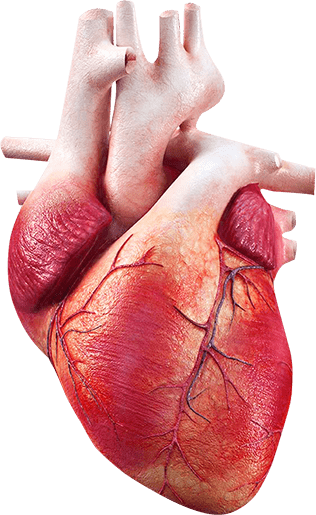DNA test for genetic predisposition to coronary heart disease
Coronary heart disease (CHD) is one of the most common diseases of the cardiovascular system. The disease is the absolute leading cause of death and loss of work capacity.
by e-mail (anytime):
 EN | USD
EN | USD
by e-mail (anytime):
Coronary heart disease (CHD) is one of the most common diseases of the cardiovascular system. The disease is the absolute leading cause of death and loss of work capacity.


In essence, CHD is a relative or absolute lack of oxygen reaching the myocardium (the heart muscle) through the coronary arteries (the vessels that supply the heart). In the absolute majority of cases, this phenomenon is linked to accompanying atherosclerosis.
Atherosclerotic plaques partially block the lumen of a blood vessel, causing hypoxia, which in severe cases culminates in necrosis of an area of the muscle. In other cases, blood flow may be blocked by vessel spasm or thrombosis.
Relative hypoxia occurs where the heart muscle needs more oxygen but the supply of oxygen cannot be increased. In coronary heart disease patients, this happens when blood pressure is raised, when the frequency of heart contractions is suddenly increased, or when the heart muscle itself is pathologically enlarged (myocardial hypertrophy).
Thousands of studies and monographs have been devoted to the problem of coronary heart disease , but there is as yet no definitive answer to the question of what causes it.
Certain risk factors that definitely raise the likelihood of CHD have been shown to be important:
The role of the genetic factor in the development of coronary heart disease is demonstrated by many years of clinical observations and studies. People whose close relatives suffer from CHD have a 4-5 times greater risk of developing the disease than the population average, and the risk nearly doubles again if those relatives became ill before the age of 55. The disease risk dependence for twins is also indicative: if one twin becomes ill with CHD, the risk to the other increases 7-fold as compared with the average.
By studying family cases of CHD, scientists have come to the conclusion that the risk of the disease rises particularly sharply if the closest relative with coronary heart disease is a woman, or if the diagnosis was made at a young age. In cases of family illness, non-genetic factors such as dietary habits formed in childhood are also thought to play a not insignificant role. However, the role of the genotype in the occurrence of CHD is not open to doubt.
Genetic research has identified a whole group of genes that are implicated in the disease. They encode structural and functional signs that may in time lead to atherosclerosis and coronary heart disease.
A confirmed genetic predisposition to CHD requires a consultation with a specialist to compile a program of active heart disease prevention, which will enable the disease to be prevented or its course to be substantially alleviated.
There are several classifications of coronary heart disease. The disease is categorized according to its symptoms and the features of its course.
caused by an acute impairment of the working of the heart caused by ischemia (hypoxia) of the myocardium;
a transient condition usually manifested as a characteristic pain behind the breastbone;
necrosis of an area of the heart muscle caused by severe hypoxia. Where the outcome of the disease is favorable, the necrotic area is replaced with connective tissue; where it is unfavorable, the infarction ends with acute heart failure and death;
develops following an infarction is manifests as a proliferation of connective tissue at the necrotic site;
occurs in situations where an area of the conducting system of heart, which is responsible for creating or maintaining the normal rhythm of cardiac contractions, suffers hypoxia.
Some classifications include cardiomyopathy, heart failure and the painless form of the disease under CHD, while others do not distinguish cardiosclerosis or arrhythmia as separate categories. However, the first three items in the list above are always the most important.
Each year, thousands of people around the world have their first encounter with the dangerous manifestations of coronary heart disease. Many of them are doomed to disability or a severe and rapid outcome.
Prevent CHD now: take a DNA test for genetic predisposition to coronary heart disease, and make prevention as effective as possible.

Depending of the form and type of course, CHD can manifest a variety of symptoms that indicate hypoxia of the heart and may constitute a grave danger to the patient.
Against a background of complete health, or under the influence of trigger factors, the heart suddenly stops. Breathing and consciousness are absent, and there is no pulse. Nowadays, cases of cardiac death within 1 hour of an acute deterioration in condition, with no other causes, are also classed in this CHD category. The only chance of saving the patient is by emergency resuscitation. If this succeeds, the patient is examined to identify signs of myocardial ischemia, and support treatment will be prescribed if necessary.
The most common form of chronic CHD is angina. The clinical picture is characterized by spells of pain – “angina pectoris”. In the classic form, the pain is sharp, constricting and burning, and is located behind the breastbone. The pain may extend to the left arm, left shoulder, or sometimes to the jaw, back and abdomen. Accompanying signs are weakness, clammy sweat, shortness of breath, fear, and palpitations. An angina attack can last for up to 15 minutes. A characteristic sign is that a good effect is obtained from fast-acting nitrate drugs such as nitroglycerine.
Several forms of angina are distinguished
is the most common form. Attacks occur under load, when the heart muscle’s need for oxygen is increased but the vascular lumen prevents it being met. Physical exercise, raised blood pressure, high body temperature and even mental stress - any strong emotion accompanied by an increased rate of cardiac contractions - can all precipitate an attack. Attacks recur at certain intervals and can be relieved with nitroglycerine.
is sometimes viewed as a pre-infarction condition, and is a serious danger to the patient. It is a particular type of exacerbation of CHD, in which attacks occur in response to minimal stress and become more frequent and longer-lasting, while the pain syndrome becomes particularly severe.
attacks occur for no apparent external cause, at rest, frequently during sleep. In some classifications, this form is categorized as unstable angina.
the symptoms do not fit the classic clinical picture. May manifest as abdominal, spinal or lower back pain. Sometimes, instead of pain syndrome, there are attacks of arrhythmia, nausea, and general malaise.
The first signs of a myocardial infarction (heart attack) are highly similar to the symptoms of angina: in the classic form, the sign is a crushing pain behind the breastbone. The pain may be more pronounced than usual (in patients with the chronic form of CHD), but the reverse may also be true. It is not unknown for the pain to be located atypically – in the abdomen, throat, head or arm.
A characteristic symptom of infarction is the long duration of the pain attack coupled with the ineffectiveness of taking nitroglycerine and other nitrates. Coughing, shortness of breath, and heart rhythm disturbance may also occur. Normally, only narcotic analgesics can stop the pain.
The clinical picture is strongly dependent on the site of the damage and the volume of resultant necrosis. Minor cases may proceed without symptoms and be detected coincidentally by ECG signs.
A major infarction is extremely dangerous: a large area of damage may cause the heart to stop or rupture.
is the principal diagnostic tool. Electrocardiography makes it possible to see the ischemia (the temporary myocardial hypoxia), the infarction and its consequences, and to record complications in the shape of rhythm disorder, aneurysms etc.
is an ultrasound technique that is informative in identifying complications and delayed consequences.
these measure the level of cardiotropic proteins, a raised concentration of which indicates necrosis of the heart muscle. Indicators of lipids, cholesterol, blood cell count, etc are also examined.
is an ex-ray technique using contrast. The contrast agent is injected into the coronary arteries, then an x-ray photograph is taken so that the location and degree of blood vessel narrowing can be observed.
The aim of CHD treatment is to prevent dangerous complications, improve the patient’s quality of life, and reduce the frequency of attacks.
Effective treatment is impossible without the elimination of trigger factors.
The following are therefore recommended:
Giving up smoking;
Correct diet;
Physical load determined by a specialist according to individual tolerance;
Appropriate treatment of obesity, high blood pressure, and diabetes;
A gentle work and leisure regime.
CHD treatment makes use of:
Anti-angina drugs to relieve spasm in the coronary arteries and stop angina attacks;
Antithrombotics: these reduce the risk of thrombotic complications;
Statins: used to normalize lipid exchange and delay the progression of atherosclerosis;
Antiarrhythmic and hypotensive agents: as indicated.
A unique approach that makes possible a substantial improvement in the course of angina, and, when performed in emergency, enables necrosis of the heart muscle during an infarction to be prevented. The operation is carried out percutaneously: a probe is introduced into a large peripheral artery such as the femoral artery, and guided by x-ray to the damaged area of the coronary artery. Special manipulators enable the vascular lumen to be dilated with a special balloon, or a stent – a prosthetic tube to keep the artery open – to be inserted.
Surgical treatment is performed both in chronic forms of CHD, when the operation aims to improve the course of the disease, and in cases of infarction requiring surgical elimination of severe consequences (aneurysms, rupture of a septum or arterial wall, etc).
Narrowing of the lumen of the coronary artery in angina is an indication for surgical treatment. Coronary shunting – the insertion of a shunt, an artificial “bypass route” to restore normal blood flow – is used for this purpose. The most popular operation is CABG – coronary artery bypass grafting- which involves joining the coronary artery to the aorta by means of a shunt.
A properly performed operation enables attacks to be substantially reduced in frequency and severity, and the risk of myocardial infarction and other dangerous complications to be decreased.
In view of the particular danger of CHD, prevention is considered the top priority.
Preventive measures include:
A DNA test for genetic predisposition to coronary heart disease can be a useful landmark in finding the right approach to preventing the disease. The test results can be used to draw up an individual program of preventive measures, as well as providing powerful motivation to make lifestyle adjustments, and helping with diagnosis in atypical cases of the disease.
Don’t put off thinking about your health: start effective prevention of coronary heart disease as soon as you can!
